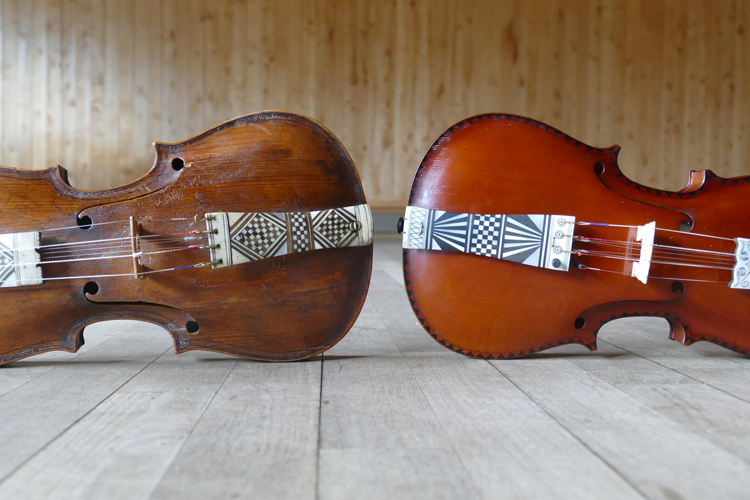The Hardanger fiddle is a traditional Norwegian stringed instrument and is considered the national instrument of Norway. It closely resembles a violin in modern designs, but with eight or nine strings instead of four and thinner wood. The Hardanger fiddle is also known as Harding fiddle, Norwegian hardingfele, or hardingfela.
Pictured below: a fiddle made by Trond Isaksen Flatebø (1713-1772) around 1750. He made many fiddles and sold them around in Norway. He and his father Isak Botnen were two of the main luthiers of early instruments. The other fiddle is a copy made by Wiebke Lüders. She works at the Ole Bull Academy.

Typically, the Hardanger fiddle has distinct F-holes (f-shaped openings located on both sides of the violin’s body) that are sunken and have straighter edges. The instrument has four strings that are played like a violin, while the rest of the strings, called sympathetic strings or understrings, resonate under the influence of the other four. These extra strings are secured with extra pegs at the top of the scroll, effectively doubling the length of a Hardingfele scroll when compared to a violin.

The Hardanger fiddle’s bridge is unique in that it is taller and wider, allowing for the easy performance of double-stops. It is mainly used in the southwest part of Norway for dancing, accompanied by loud foot stomping. The instrument is often highly decorated with carved animals or women’s heads as part of the scroll, extensive mother-of-pearl inlay, and black ink decorations called ‘rosing’ on the body of the instrument.
The earliest known example of the Hardanger fiddle dates back to 1651, and the modern layout with a body much like the violin became the norm around 1850.

Hardanger Fiddle Schools
One of the leading educational centers for Hardanger fiddle is the Ole Bull Academy (Ole Bull Akademiet). The Ole Bull Academy’s objectives include teaching Norwegian folk music and folk dance to college and university students and providing a university-level education for folk musicians. Moreover, it acts as a meeting place for different genres of music, and increasing knowledge about Norwegian folk music through research, publishing, student exchange, and international collaborations.
Hardanger fiddle makers
Norway
Bård Riise Hoel; Helge M .Bergnord; Knut Opheimsbakken; Lukas Pawelka; Oddrun Hegge; Ole Gjerde; Olav Viken; Ottar Kåsa; Salve Håkedal; Sigvald Rørlien; and Wiebke Lüders.
United States
Karen Rebholz; and Wulffenstejn Hardanger Fiddle and Mandolin Works.
Top Hardanger Fiddle Players
Notable hardingfele players include: Alexander Røynstrand, Annbjørg Lien, Anne Hytta, Benedicte Maurseth, Daniel Sanden Warg, Erik Sollid, Gro Marie Svidal, Guro Kvifte Nesheim, Hallvard T. Bjørgum, the late Hauk Buen, Jan Beitohaugen Granli, Knut Buen, Liv Merete Kroken, Nils Økland, Olav Luksengård Mjelva, Ottar Kåsa, Per Anders Buen Garnås, Sigrid Moldestad, Sven Nyhus, Vidar Lande, and Øyvind Brabant.
Hardanger Fiddle Organizations
Hardanger Fiddle Association of America, P.O. Box 23046, Minneapolis, MN 55423-0046, USA.
—
Special thanks to Arne Anderdal, Høgskulelektor at Ole Bull Akademiet.


